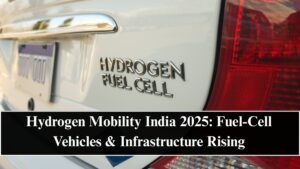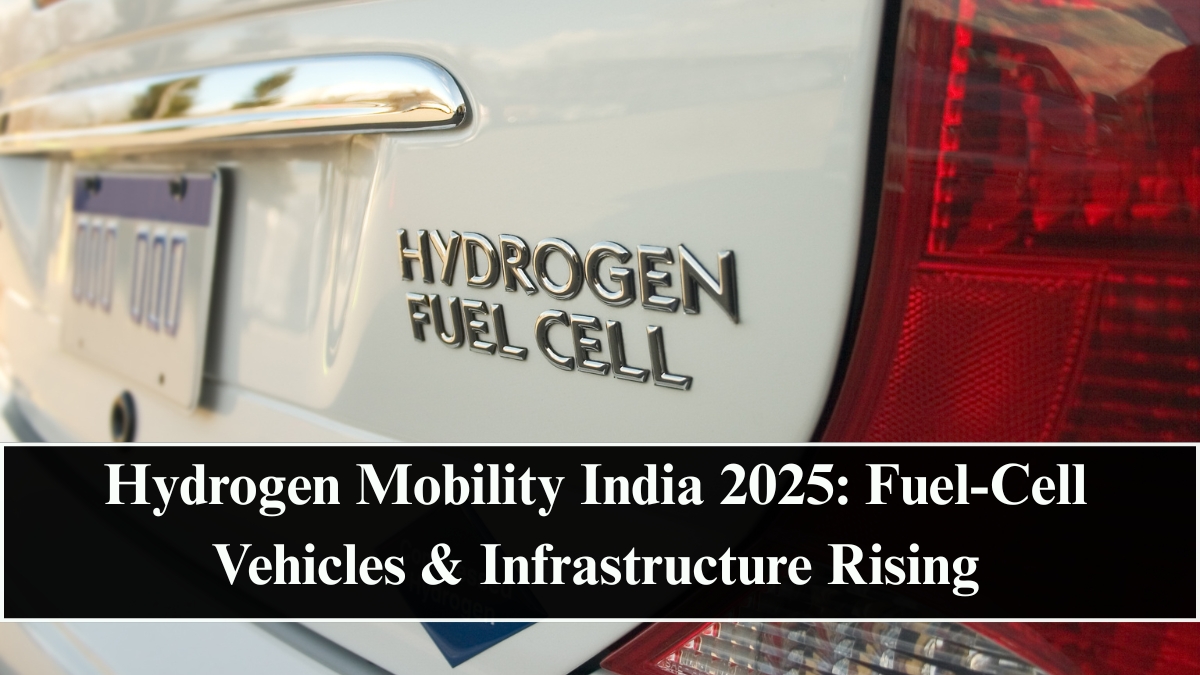As India moves toward cleaner mobility, Hydrogen Mobility India 2025 has become one of the most promising frontiers in the country’s journey to zero emissions. While electric vehicles dominate the current market, hydrogen-powered transport is beginning to gain serious traction — especially in commercial and heavy-duty segments where battery limitations persist.
In 2025, the Indian government, energy companies, and automakers are coming together to build a national hydrogen ecosystem — spanning production, distribution, and mobility infrastructure.

Why Hydrogen Mobility Matters
Hydrogen is considered the fuel of the future because of its ability to deliver long-range performance and quick refueling with zero tailpipe emissions. Unlike battery EVs, which rely on long charging times, hydrogen fuel cell vehicles (FCEVs) generate electricity onboard by combining hydrogen with oxygen, emitting only water vapor as exhaust.
This makes hydrogen mobility ideal for trucks, buses, and fleet operations, where downtime and heavy loads make battery-electric solutions less practical. For India, where logistics and long-haul transport form the backbone of the economy, hydrogen provides a sustainable path to decarbonization without compromising efficiency.
India’s Hydrogen Mission and Policy Push
In 2025, the National Green Hydrogen Mission, launched by the Government of India, has taken center stage in driving this clean fuel revolution. The mission targets producing 5 million metric tonnes of green hydrogen per year by 2030, with strong incentives for research, production, and deployment of hydrogen technologies.
The government is also offering tax incentives and subsidies to both automakers and infrastructure developers investing in hydrogen fuel cells, storage systems, and refueling networks. Policies under the FAME-II scheme are being expanded to include hydrogen-powered public transport and heavy commercial vehicles, making India a key player in the global hydrogen race.
Building Hydrogen Infrastructure Across India
The biggest challenge for hydrogen fuel cell vehicles India 2025 is building an accessible refueling network. To tackle this, energy companies like Indian Oil, NTPC, Reliance, and Adani Group are setting up pilot hydrogen refueling stations in cities such as Delhi, Pune, and Bengaluru.
Indian Oil has already commissioned India’s first public hydrogen station for buses, while NTPC is testing hydrogen-fueled trucks and intercity buses on major highways. These early projects are laying the foundation for a scalable hydrogen economy.
Meanwhile, startups and R&D centers are working on modular electrolyzer technology — capable of producing hydrogen directly from renewable energy sources like solar and wind — making fuel production cleaner and locally sustainable.
Hydrogen in Commercial and Public Transport
The commercial transport segment is where hydrogen is gaining the fastest traction. Companies like Tata Motors, Ashok Leyland, and Toyota Kirloskar are testing hydrogen-powered buses and trucks designed for Indian road conditions.
For example, Tata’s hydrogen fuel cell buses developed under a partnership with Indian Oil are already operating on pilot routes, demonstrating high efficiency and quick refueling times of under 10 minutes. Similarly, Ashok Leyland is working on hydrogen internal combustion engine (H2-ICE) trucks for medium and long-haul operations.
These initiatives are making hydrogen mobility not just a futuristic idea but a real-world alternative to diesel.
Hydrogen Mobility vs Battery EVs: Complementary Futures
While some see hydrogen as a competitor to electric vehicles, in reality, both technologies are complementary. Battery EVs are best suited for short distances and personal cars, whereas hydrogen fuel cell vehicles excel in heavy-duty and long-distance applications.
By integrating both, India can build a diverse and resilient clean transport ecosystem that addresses different mobility needs while reducing fossil fuel dependency. The future may see hybrid fleets combining battery-electric and hydrogen systems to balance cost, efficiency, and range.
The Road Ahead for Hydrogen in India
The next few years will be crucial for scaling hydrogen mobility. As infrastructure expands and production costs drop, fuel-cell vehicles will gradually become commercially viable. With the government’s strong policy framework and industrial collaboration, Hydrogen Mobility India 2025 is positioning the nation as a global hub for hydrogen innovation.
India’s vision goes beyond just vehicles — it’s about integrating hydrogen into the broader energy ecosystem, including industrial use, grid stabilization, and export potential. The journey toward zero-emission transport has officially entered a new phase powered by the most abundant element in the universe.
FAQs
What is hydrogen mobility?
Hydrogen mobility refers to the use of hydrogen fuel cell technology to power vehicles like cars, buses, and trucks, offering zero-emission transportation.
How do hydrogen fuel cell vehicles work?
Hydrogen fuel cell vehicles generate electricity by combining hydrogen and oxygen in a fuel cell, producing water vapor as the only byproduct.
Is hydrogen mobility practical for India?
Yes. Hydrogen is ideal for India’s heavy transport sector due to quick refueling, long range, and compatibility with renewable energy production.
What is India’s National Green Hydrogen Mission?
It’s a government initiative launched to promote hydrogen production, storage, and mobility, aiming to make India a leader in clean hydrogen technology by 2030.
Are hydrogen vehicles available in India yet?
Yes, several pilot models like Tata hydrogen buses and Ashok Leyland trucks are under testing, with public rollout expected as infrastructure expands.
Click here to know more.
